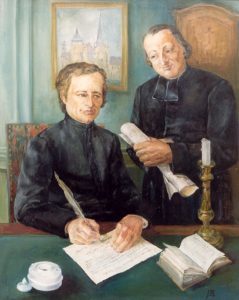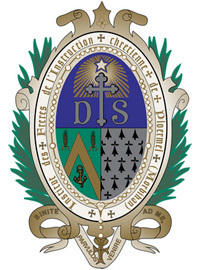 On June 16, 1819, Jean Marie de la Mennais, vicar of Saint-Brieuc, and Gabriel Deshayes, pastor at Auray and vicar general of Vannes, formed the Brothers of Christian Instruction by signing a treaty uniting their efforts to educate the working class in impoverished France. They vowed to carry the message of the gospel and the rudiments of knowledge to every child in need throughout the region and received Catholic papal approval in 1891. The congregation of the Brothers of Christian Instruction grew rapidly, soon extending their mission into Bulgaria, Turkey, Egypt, Spain, England, Canada, and the United States.
On June 16, 1819, Jean Marie de la Mennais, vicar of Saint-Brieuc, and Gabriel Deshayes, pastor at Auray and vicar general of Vannes, formed the Brothers of Christian Instruction by signing a treaty uniting their efforts to educate the working class in impoverished France. They vowed to carry the message of the gospel and the rudiments of knowledge to every child in need throughout the region and received Catholic papal approval in 1891. The congregation of the Brothers of Christian Instruction grew rapidly, soon extending their mission into Bulgaria, Turkey, Egypt, Spain, England, Canada, and the United States.
Throughout Walsh's history, the Brothers have played an active role in the prosperity of the University, serving as faculty during the original years and playing an integral part in the growth and development of our facilities and programs. Several have served as President.
Symbolism of the Brothers of Christian Instruction Coat-of-Arms

- The upper half features a cross, bracketed by the initials D and S, which constitutes the traditional emblem of the Congregation. The D.S. stands for "Dieu Seul", in English "For God Alone."
- Above the cross, a radiant star symbolizes the Brothers' mission to spread the knowledge and love of Jesus Christ. The bottom half recalls the origins of the Congregation.
- The section with the golden chevron, the ears of wheat and the silver anchor refers to the la Mennais family. Pierre Louis Robert, a ship owner and importer, had generously supplied wheat and other cereals to the people of Brittany at a time of near-famine, thus earning letters of nobility entitling him to add the title de la Mennais to his surname.
- A silver field dotted with ermines, is taken from the emblem of Brittany, where the Congregation was founded.
- Encompassing the escutcheon is a rosary, which signifies the devotion of the Brothers to Mary, their Mother, and patroness of the Congregation. The official title of the Congregation is given on the border between the rosary and the cartouche.
- The olive branches suggest the spirit of peace and charity animating the Brothers in their mutual relations and in their dealings with others, especially their students. Below the armorial display is the Divine Master's admonition to his disciples, "Let the Children Come to Me."
